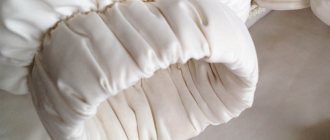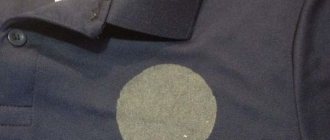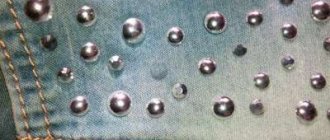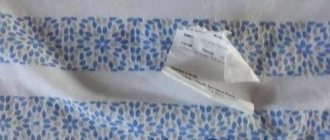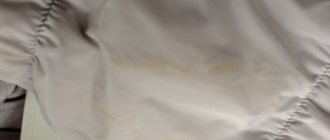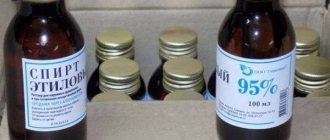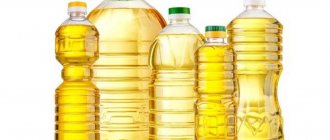Sequins, sparkles, and artificial feathers are integral elements of many children's works. Children love colorful glitter because of the sparkle and sparkle.
Use glitter in holiday makeup. Children's carnival costumes are decorated with sequins. Decorate holiday packaging.
But the main problem with these decorative and makeup elements is that they are difficult to get rid of.
However, cleaning glitter from clothes, hair, and floors is not a problem if you know how to clean any surface.
The best ways to remove rhinestones from clothes
If you do handicrafts, you can purchase a simple soldering iron for rhinestones. This is a special device that can dissolve glue using temperature.
This soldering iron should be used to heat up the rhinestone. The glue underneath will melt. And you can simply remove it with tweezers. Just don't do it with your hands. After all, everything is hot there.
You can also use a solvent, such as white spirit. It must be applied to the fabric from the back side and held there for 1 minute. After this, the rhinestone should come off. Only in this case you will need to check the effect of the solvent on a tissue sample. Otherwise, you risk ruining the item.
Removing rhinestones with an iron
Heat the fabric from the inside out with an iron. Just to start, put gauze on it so as not to damage it.
After this, the rhinestone can be peeled off. You just need to do this quickly. Otherwise, the glue will harden again and you won't be able to do anything.
Among other things, you can freeze your item. Place it in the freezer for 40 minutes. After this, the shiny elements can be peeled off. But you should look at what structure the glue has. If it is resinous, then everything will work out. But another type of adhesive cannot be frozen.
Recipe against rhinestones
Among other things, you can peel rhinestones off clothes using a chemical reaction. To do this you will need to mix in equal parts:
- Vinegar;
- Ammonia;
- Boric acid;
- And add the required amount of water.
You can soak the item in this for one hour. after which you can remove the rhinestones. This also needs to be done quickly, otherwise the glue will harden again.
Additionally, you need to ask hardware or nail stores about rhinestone remover. If there is an official solvent for this, then try it.
Prevention and precautions
When removing such crystals, there is always a risk that glue stains or simply faded marks will remain in their place. This means you shouldn’t act rudely.
Plus, always look at the things you buy. Choose them carefully. And then you won't have to delete anything unnecessary.
Some girls glue rhinestones to their eyelashes or nails. Removing the glue in these places is the most difficult. Therefore, it is better not to resort to such beauty techniques, so that you don’t have a bad time later.
Very often, women's wardrobe items are replete with an abundance of various decorations. For some it is a fashionable element of decoration, but for others it is an excess. For this reason, some women, when buying things with glitter, try to remove them. Very often, when worn, they fall off on their own, leaving stains on the fabric. There are simple ways to remove rhinestones from clothes without leaving marks, without damaging its appearance.
Not all women are willing to buy products with rhinestones. Often their large number becomes an obstacle to acquisition. Many girls or women want to see more formal things in their wardrobe, or change the design, remove something unnecessary. Some people want to change the stones and make their own design decisions.
To find a way to peel off rhinestones from fabric, you need to know what kind of glue they were used to fix. To secure this type of jewelry to clothing, certain types of glue are used. They must be heat-resistant, strong, and penetrate the structure of the material. Typically, manufacturers use the following compositions as an adhesive base:
- thermoplastic adhesive;
- superglue or acrylates;
- silicone;
- Water-based PVA;
- epoxy with hot or cold fixation.
Each of them has its own characteristics, which is very important for their removal without harm to clothing items. For example, a cold fix epoxy is applied to the rhinestone and then it is bonded using heat. Because of these properties, it is also called thermoactive. A cold fixation analogue usually consists of two components, which requires the selection of separate solvents for each.
The thermoplastic composition is applied to the decoration with a special gun. Then the rhinestone is glued to the material.
There are compositions that can be applied immediately without the use of heat:
- "Super glue";
- "Second";
- "Moment";
- "Acrylic".
They all belong to the same species, differing only in different names. The main substance in their composition is cyanoacrylate. It reliably fixes jewelry on a fabric basis. For some jewelry, silicone or silicone glue is used. This chemical compound is widely used in various fields. It is often used in construction and to create creative compositions.
PVA glue is considered a universal composition, including for gluing rhinestones. It is usually used in the production of inexpensive items, so jewelry falls off very quickly during wear.
Removing stones by heating and cooling
There are several gentle options for removing rhinestones from clothes without leaving marks on the fabric. Many of them are quite accessible at home. The simplest of them is the cooling method.
To do this, the selected item is placed in a plastic bag and left in the freezer for 7-8 hours at a temperature of -24 o C. The glue used becomes brittle after freezing. This property makes it easy to remove decorations from fabric. They can be removed with a brush, and traces of glue can be beaten with a wooden hammer. After this, the item should be left in warm water, rubbing the stains with laundry soap. After a while, wash everything thoroughly by hand.
An alternative to freezing is the heating method. In this way, decorations are applied to clothing and removed. To do this, the adhesive composition must be softened. You can use a hot iron by applying it to the surface of the rhinestones from the wrong side of the fabric. Leave it for a while and the stones will easily come off. Remains of glue are removed with an eraser or cotton pad. However, this method requires quick action, since the composition cools instantly.
Paper sheets are also used with the iron. They are placed on top and bottom and smooth the surface. All softened glue remains on the paper. Stains are removed from natural and white fabrics using soda and detergents. The item must be washed in a washing machine using a long program.
The marks will be removed when the item enters an alkaline environment. However, this method is not suitable for all types of adhesive mass. Some of them stick tightly under the influence of high temperature.
You can also use a soldering iron to heat the glue. With its help, the adhesive composition softens, then the jewelry is removed with tweezers. This must be done carefully so as not to get burned. This method works when using thermal rhinestones. Most often it is used to change decorations and make minor repairs.
Prevention and useful tips
To prevent the appearance of shine, you need to care for things correctly. The gloss will not appear if:
- regularly clean clothes from sweat and dust;
- thoroughly rinse items from detergent;
- treat the stain with shine using movements from the center to the edges. On the collar - from the edges to the center; iron from the inside out using an iron;
- Install a Teflon nozzle on the iron.
There are many ways to remove shine from clothes. There is no particular difficulty in this. If everything is done carefully and carefully, your favorite thing will still serve.
Source
Using gasoline and hot water
You can quickly and efficiently remove crystals using gasoline. The most suitable composition for this is Zippo lighter. It is odorless and contains gentle substances, which is very important so as not to damage the material. It is advisable to conduct a test before use to ensure that the fabric structure is not damaged. If everything is in order, then turn the item inside out and apply gasoline in the area where the jewelry is attached. You should leave it for 5-7 minutes, then turn it inside out and carefully remove the crystals with tweezers.
An effective result is obtained by a solution using hot water in a composition with some components:
- boric acid;
- ammonia;
- vinegar 9%;
For 1 liter of water you need to take 1 tablespoon of each component and prepare a solution. Place the desired item in it and leave for 60 minutes. After this time, you can take out the item and remove the rhinestones, and then wash the clothes.
Very often, white spirit is used to remove it from denim. However, such a product has a bad effect on the structure of the denim material. In some cases, nail polish removers or solvents are used. They are applied like gasoline, but to use this method you must first conduct a test.
Getting rid of scorch marks
The effect of removing iron marks largely depends on how quickly measures are taken. The sooner you start eliminating them, the higher the chance of saving your clothes.
To prevent the burned fibers from setting, the affected area should be immediately run under a tap with cold water. Then dilute the washing powder into a paste, apply to the stain, and rub gently. Rinse in cold water.
Note! Do not use hot water to avoid setting the stain.
Mechanical methods
If shine appears on thick fabric, washing is prohibited, or you don’t have the necessary products at hand, another way to remove shine (or burn marks) from clothes will come in handy. It can be erased with an eraser, pumice stone, fine sandpaper or a nail file. Be careful not to damage the fibers. The effect will be enhanced if you first apply lemon juice to the stain and let it dry.
Removing marks on fabrics
You can remove crystals from clothes with virtually no problems. All that remains is to find out how to remove traces of rhinestones on clothes without damaging them. There are several options for removing glue stains. They are quite simple and affordable.
Vinegar or denatured alcohol can effectively remove glue stains. To do this, take a cotton pad, moisten it in one of the liquids and wipe the contaminated areas. After this, it is recommended to wash the item after 40 minutes.
For coarse and denser fabrics, acetone can be used. However, it is completely unsuitable for synthetic products.
Another option is silica, which can be purchased at a hardware store. It must be handled carefully when removing stains from clothing. It is considered very effective and can remove any contaminants.
When choosing different methods, it is better to give preference to the safest types. It is advisable to carry out tests before this, which will help not damage the structure of the fabric and maintain the attractive appearance of the product after removing the rhinestones.
The abundance of shiny, iridescent rhinestones on women's clothing is a tribute to fashion and a joy for someone's eyes. But not everyone loves and welcomes this, in addition, rhinestones can quickly fall off, fashion will change, and the problem of how to remove rhinestone glue from clothes will arise and become insurmountable. But don’t despair and throw away your favorite thing or not buy what you liked because of the abundance of these sparkles. Without rhinestones, clothing can regain its relevance and attractiveness. You just have to carefully remove them and remove traces of strong glue.
There are different types of glue
Before you remove the glue from the rhinestones from your clothing, you need to try to determine what exactly was used to attach them. Typically, all types of rhinestone glue are very strong, fabric penetrating, heat resistant, or self-curing. That's why it's so difficult to remove them. If the item is handmade, it is easier to find out exactly what the craftsman used to glue the “glitters” by contacting him for an explanation. If the purchase is from a store, then you will have to determine it visually or by trial and error.
Interesting fact! A little philology. Do you know which is correct: rhinestone or rhinestone? In fact, the dictionary allows both options. What distinguishes expensive, real sparkles is their composition: crystal and a little lead.
Types of glue for rhinestones can be:
- “Superglue” and its analogues (acrylate);
- thermoplastic adhesive;
- epoxy, hot or cold fix;
- silicone;
- Water-based PVA.
Hot-fix epoxy adhesive is usually already applied to the rhinestone, and is attached to the material under heat (with a hot iron, for example). Another name or characteristic of such glue is thermoactive.
Cold fix epoxy adhesive can consist of two components. For each you will have to select a separate solvent.
Thermoplastic glue is applied to the rhinestone using a special gun. The decoration is then glued to the clothing.
Acrylic, “Superglue”, “Moment”, “Second” - these are the names of one glue that is applied without heating. It contains cyanoacrylate. With its help, you can securely attach small compositions of rhinestones to clothes.
In some cases, silicone or silicone glue may be used to secure the rhinestones. This is a high-molecular chemical compound that finds diverse applications in many areas of life - from construction to creativity.
PVA glue has long been recognized as universal. Rhinestones are also attached to it. But, as a rule, it is used on cheap, poor quality things, and the rhinestones quickly fall off, but its traces are easier to remove.
Adhesive removers
In addition to the types of glue for attaching rhinestones, when removing traces of it, you need to know the properties of the material from which the clothes are made. Acetone, which is very helpful in this matter, is not at all suitable, for example, for acetate fabrics. Under the influence of aggressive solvents, the fabric can lose its pattern, “sit down”, and even become covered with holes. It is usually advised to try the product on an inconspicuous small area of the product, look after some time at the result of its effect and then decide on its use.
Substances that will help remove traces of glue from rhinestones from things:
- acetone;
- nail polish remover without acetone;
- solvents type 646 and containing ethyl acetate;
- dimexide;
- alcohol mixed with turpentine;
- petrol;
- White Spirit.
Depending on the type of glue, we choose how to remove it reliably and quickly. But the main thing is that there are no marks left on the fabric, and the item is not hopelessly damaged.
Acetone and other solvents work well with acrylic and silicone glue. But you can spoil, deform the fabric or discolor the design.
Regular pharmaceutical dimexide will also help remove traces of Moment glue. But you will have to wear gloves to avoid getting a chemical burn. Washing clothes with powder and conditioner can remove the unpleasant garlic smell of the chemical. Opinions are divided as to whether or not to dilute dimexide with water. An aqueous solution has a weaker effect on glue, but is more gentle on fabric. The optimal ratio must be selected experimentally. It is usually recommended to start with a less concentrated solution, gradually moving to a more saturated one.
Traces of epoxy resins are removed with turpentine, and turpentine stains with alcohol. After removing the glue, the item must be washed.
PVA glue and other similar water-based glues are easily removed during washing. It is better to wash by hand to check the results periodically.
Based on reviews on forums, you can find out that Nail polish remover does a good job of removing glue stains from rhinestones.
Gasoline and white spirit are also used to remove traces of glue from clothes, applying them from the inside out to the desired place. Testing for fabric resistance to their effects is mandatory in this case, as in the case of other aggressive solvents.
The quantity and ratio of the product and water (if necessary) will have to be selected by yourself, as in the case of dimexide, carefully checking its effect on the fabric. It is very important to follow general precautions when using aggressive liquids:
- use gloves;
- do not eat, drink or smoke while using chemicals;
- in case of accidental splashing and contact with eyes, rinse with plenty of clean water, after washing your hands with soap, and in case of a burn, immediately seek medical help;
- small children and animals should not be nearby during dry cleaning;
- the room should be well ventilated.
The general rule for removing traces of glue is to place paper towels, napkins or a clean cloth under the item being treated. They need to be changed when they get wet. The product must be applied carefully so that less contamination is spread to clean areas.
Advice! After using any of the listed chemicals, the item must be washed in a washing machine or by hand in warm water and laundry soap, thoroughly lathering the areas where the glue was removed. During ironing, you need to place a clean cloth under the clothes so that the remaining product transfers to it, finally cleaning the item.
Try gentle ways
As an alternative to aggressive liquids: solvents, chemicals, gasoline, more gentle means and methods can be offered. Some of them are quite unusual. For example, freeze an item from which you need to remove glue from rhinestones: keep it in the freezer at a temperature of –24˚ C for about 7-8 hours.
For example, leaving it overnight, wrapped in a plastic bag. After this, the glue, which becomes brittle when frozen, can be quite easily removed or brushed off by beating its traces with a wooden hammer. Then the item needs to be soaked in warm water with laundry soap and washed.
It is best to wash by hand to ensure that any residue is completely removed during washing. The glue, which does not change its structure even at –24˚ C, is treated with a special aerosol freezing, with the help of which the temperature on the surface becomes –40˚ C. Then everything is as described above.
Using an iron or soldering iron, you can not only glue rhinestones, but also, on the contrary, soften the glue with which they are glued. To do this, you need to apply a hot iron to the fabric from the inside out and hold it for a while. Then quickly try to remove the softened glue with an eraser or cotton pad. You need to act quickly because the glue cools instantly.
There is also a method using an iron, when paper is placed on top and bottom of the stain and then ironed. The glue softens and transfers to the paper. But this method is not suitable for all types of glue. Some of them finally harden under the influence of temperature and firmly adhere to the fabric.
If you put a white item made of natural fabric in an automatic washing machine, add detergent and soda, and then select the longest washing program, then traces of glue from rhinestones will completely disappear under the influence of an alkaline environment.
How to Remove Glitter from Skin
Ideally, the best way to remove glitter from your skin is to take a hot shower.
Another method is coconut oil. Melt the butter, dip your fingers in and apply to the skin in a circular motion. Then wipe your face and neck with a napkin or a cotton pad soaked in water. Wash off any remaining oil (and possibly glitter) with soap and water.
To get rid of small areas, wrap your finger in tape with the sticky side facing out and remove. Replace the tape if it has accumulated a lot of glitter or has lost its stickiness.
Secrets that will help preserve fabric from damage
There are several tricks to use when removing rhinestone glue from fabric. The number of recommendations is small, but each of them is of great importance:
- When a chemical adhesive solvent is used, the product becomes stringy or jelly-like. Then you can remove the glue quickly and efficiently using a stationery eraser.
- Aggressive solvents must be applied to the glue from the wrong side of the fabric. The fabric should be well saturated with the solvent, then the glue will come off on its own.
- If a spray is used, then apply the product from the front side. After processing, the product must be washed.
- The new product is pre-tested on the reverse side of the product to check the fabric's reaction to the composition.
- Washing after the procedure is mandatory.
Traditional methods and devices for cleaning fabrics
If there is a fear that chemicals will ruin the fabric, then you can resort to folk remedies. Most often, it is precisely these methods and methods that the owner of the wardrobe uses, because they are more accessible and less aggressive in impact.
How to remove glue from clothes using traditional methods:
- A mixture of vinegar and water is the easiest and most effective way to deal with stains of any complexity. If the glue does not come off well, then you should add 1 teaspoon of ammonia to the composition.
- A strong remedy is ammonia, which is diluted in equal parts with water. Apply the solution exclusively to the wrong side.
- The most popular remedy is turpentine. But the problem is that turpentine can eat away the color of the fabric, so you should leave it for no more than a few minutes, and then wash the product thoroughly.
Gasoline can also be considered a folk remedy.
Household chemicals
The remedies are used immediately or when home remedies do not help. Options for removing shine:
- Soak the disc in Vanish, apply lass, after 10 minutes. wash off the stain remover. Wash the product with Domal Sport Fein Fashion, Laska, Profkhim.
- Apply K2r spray and leave until dry. Clean with a brush and wash the product.
- In some cases, bleach helps. Use only on non-fading fabrics.
Special products for removing glue from rhinestones from clothes
You can buy special solvents in the store that will help deal with the problem. Typically, these types of products are very effective and the cleaning process does not require much effort.
The most popular option is solvent 646. Its price is very reasonable and depends on additional qualities and chemical composition. Using the product is simple and easy, so no one will have any problems with it.
Every home usually contains acetone, which will be a wonderful analogue to any solvent. Medical alcohol can be an equally effective way to remove glue from clothes.
What types of stickers are there?
- Iron-on adhesives. A clear, solid structure when the fabric relief cannot be seen. Rich tones using shades and color transitions. They cannot withstand high temperatures, so products with iron-on adhesives cannot be ironed.
- Applications. Vinyl material is used as a base, through which the relief of the fabric is visible upon careful examination. They are not very dense in structure and are not rich in colors. Do not cut off information tags from a new product. They help you properly care for your clothes.
- Graphic images are applied to the fabric manually using special markers or paints.
- Drawings. This is an analogue of a vinyl sticker, which is transferred to the base of the material using thermal printing. Its density is low, so the structure of the image is visible to the naked eye.
Having figured out the type of image, all that remains is to figure out how to remove the sticker from clothing and what products will effectively cope with the task.
It is not difficult to remove a sticker from clothing if you know its “origin”. How to distinguish one type of sticker from another? In some cases, a label will help, which will reflect this information, but most often you have to figure it out yourself. So how do you figure out what the design is on your T-shirt or cap?
Iron-on adhesive. If the relief of the fabric is not visible, and the color scheme of the design is rich in halftones, tints and transitions, you are dealing with a thermal sticker. They are dense and cannot be ironed.
- Thermal printing design. Thermal printing and designs, as well as vinyl images, are not very dense. It will not be difficult to examine the texture of the fabric through such an image.
- Image on fabric.
- Vinyl based applique. Vinyl-based stickers are most often two-color, not too thick. If you look closely, you may notice that the relief of the material is visible through the image.
Recommendations on how to remove glue from a certain type of fabric
Before removing glue from rhinestones from clothing, it is worth deciding on the quality of the fabric and whether it will withstand the impact. When buying something with rhinestones, you should initially pay attention to the quality and composition of the fabric in order to accurately understand whether it can be cleaned of glue later. Typically, rhinestones are attached to the following types of fabrics:
- Lightweight fabrics such as chiffon, silk. It is impossible to clean them from glue. The fibers are too thin, and at the slightest impact they will simply break. The best option in this situation is to disguise it using applique or a new pattern of rhinestones.
- Thick textiles such as denim or gabardine. It is more easily susceptible to various types of influences, so here you can experiment with various means and methods.
- Knitted items and knitwear. It is difficult to remove glue from them, since the substance usually penetrates into the fibers itself. During aggressive exposure, the canvas may stretch or change color.
Other fabrics of synthetic or natural origin have their own characteristics that should be checked on the reverse side of the textile.
Iron
To make the rhinestones come off, use the method of heating them. It is usually recommended to buy a special soldering iron, but if you don’t need it in the future, why waste money.
An alternative to a soldering iron is an iron.
The method is simple and easy. Lovers of things with rhinestones simply must know it.
How to remove crystals:
- First, you should wash your clothes. You cannot use an iron to iron dirty things, this will lead to the appearance of shine, then you will have to look for how to remove it.
- After washing the product, turn it inside out and place it on a flat surface.
- Turn on the iron, heat it to the maximum temperature suitable for the type of fabric on which the experiment is being conducted.
- Place the device on the rhinestones and warm them up thoroughly.
- Quickly turn the item right side out and remove the crystals. Work while the glue is hot; when it cools, you will have to repeat the procedure with heating.
An iron can replace a soldering iron. But the clothes will have to heat up a lot, so to avoid burning holes in the material, place a sheet of paper or a thick piece of unnecessary fabric under the sole.
If you need to remove glue from a swimsuit
Often swimsuits are decorated with rhinestones to give the product shine and brightness. But due to constant exposure to water, the pebbles may become loose and fall off.
A swimsuit with rhinestones can be cleaned of glue in several ways. The most effective option is mechanical action. The fabric from which swimsuits are made is quite durable and flexible, so you can try to remove stains with a scissor blade.
If very few stones have fallen out of the overall picture, then it is better to glue new ones in their place. Then there will be no problems at all with removing the adhesive substance. You can choose gentle solvents and try to remove the glue with a stiff brush.
What glue is used to fix rhinestones
Before you begin the process of cleaning fabric from glue, you should first determine the type of adhesive. Only in this way will it be clear exactly how to remove glue from rhinestones from clothes. There are substances that are basically impossible to remove from textiles.
What kind of glue is used to glue rhinestones to clothes?
- Thermoactive glue. It is almost impossible to remove from fabric.
- Hot melt adhesive. It is applied using a glue gun. It is very difficult to remove residue from fabric.
- Acrylic glue (any brand of superglue). Easily removed with a special solvent.
- Epoxy composition. It can be easily removed with solutions that contain acetone.
Other adhesive bases are more harmless and can be easily removed. It is enough to clean the area with a stiff brush and laundry soap.
Mechanical methods
Adhesive removers are not always effective. Moreover, there is a threat of fabric damage, so sometimes it is worth using mechanical methods to remove glue residues after rhinestones.
The simplest options and methods of mechanical cleaning are as follows:
- If the rhinestones were fixed using hot glue, then thermal treatment would be an ideal option for removing glue residue. You need to attach a sheet of paper to the problem area and iron the material from the wrong side. The glue should imprint on the paper.
- Using a scissor blade, try to remove the glue from the fabric. But this method is only suitable for thick fabric.
- Place the item in the freezer for 12 hours. Then use a stiff brush to remove any remaining frozen substance.
If you choose the right mechanical method of influence, then questions about how to remove glue from rhinestones from clothes will simply not arise.
White Spirit
If the rhinestones are torn off, the T-shirt may also tear along with it, a small hole will appear in place of the decoration, but it will greatly spoil the appearance of the product.
Therefore, you should not do this; try removing the crystals using solvents. White spirit will cope perfectly with this problem. Solvent is sold in hardware stores.
Before using this product, wear gloves and protect your respiratory tract.
Removing rhinestones using white spirit is simple and easy. Any girl can handle this. Removing crystals from things:
- Wear rubber gloves.
- Take the liquid substance and soak a cotton pad in it.
- Place the disk on the decoration, but on the wrong side.
- Hold for a few minutes. After this time, the rhinestones will fall off on their own.
This method is better than the previous one, since traces of glue will not remain under any circumstances. White spirit removes rhinestones along with glue.
This aggressive composition can affect not only the skin negatively, but also the tissue itself.
To avoid permanently ruining the item, test the substance on an inconspicuous area of fabric before using it. If the material does not change in color and the quality remains the same, feel free to remove the rhinestones.
Another way to hide defects on clothes
Sometimes it is impossible to know exactly how to remove glue from clothes. Often the methods are not suitable or the type of fabric does not allow for procedures with a relatively aggressive effect on the glue. Then you need to resort to other methods of dealing with the problem that will hide the defect.
The best option is applications. This method will allow you to hide places on clothing where traces of glue remain. A new picture to hide the defect can be made from the same rhinestones. An interesting option would be appliqué made from fabrics of different textures.
In addition to bright appliqués, accessories in the form of buttons, zippers, and decorative fasteners can be used. Lace and ribbons are also a good alternative to any type of decoration. It is worth choosing the right option that will ideally highlight the beauty of the product without spoiling its appearance.
Selecting a solvent for the type of glue
If the type of glue is determined, then there will be practically no problems with what to use for cleaning.
Glue, which contains epoxy resin, can only be removed with turpentine. Turpentine stains can be removed with alcohol. At the end, the item must be washed with laundry soap, and then in the standard cycle.
Water-based glue is removed during washing with laundry soap. First you need to manually wash the problem area, and then put the item in the washing machine.
Superglue can be easily removed using solvent 646, the price of which is almost pennies compared to the saved item. It will cost you about 100 rubles. In the same way, by the way, you can save a swimsuit with rhinestones from stains.
And similar compositions can be removed using white spirit, gasoline and other household solvents. Additionally, mechanical action or several nuances of cleansing may be necessary.
Rhinestones are usually made from glass in a variety of sizes and shapes. Most often, rhinestones are applied to clothes in the form of some kind of design, but sometimes they can be used individually. Rhinestones are also attached to false eyelashes, hair, etc. Naturally, there is a need to get rid of them. How to remove rhinestones from clothes
and more, this “cheat sheet” will tell you.
How to fix glitter on your eyes?
How to Apply Glitter to Your Eyes
- Prepare the skin of your eyelids - degrease them with micellar water, and then apply a special primer to them, which has proven to be durable. ...
- Use a small fluffy brush to spread glitter
or shimmer over your eyelid.
Interesting materials:
How long are sports categories assigned? How long has the dacha amnesty been extended? How much will pensions for working pensioners be indexed? By what percentage did the minimum wage increase? How much does your pension increase from age 80? How long are international licenses issued? Funded pension, what is it and where? Funded pension what is it? When will the funded pension be unfrozen? When was the funded pension introduced?
